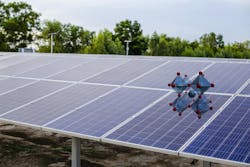University of Oxford Scientists Unveil Thin-Film Perovskite Solar Cells for Power Generation with Everyday Objects
Scientists at the Oxford University Physics Department, led by Professor of Renewable Energy Henry Snaith, have introduced thin-film perovskite coatings onto the surfaces of everyday objects like rucksacks, cars, and mobile phones to generate increasing amounts of solar electricity without the use of silicon-based solar panels.
The light-absorbing material is thin and flexible enough to apply to the surface of almost any building or common object. Oxford’s technique, which stacks multiple light-absorbing layers into one solar cell, will be utilized to connect a wider range of the light spectrum, allowing more power to be generated from the same amount of sunlight.
The ultra-thin material, using a multi-junction approach, has been independently certified to deliver over 27% energy efficiency, similar to the performance of traditional, single-layer, energy-generating materials known as silicon photovoltaics. Japan’s National Institute of Advanced Industrial Science and Technology (AIST) gave its certification before publication of the researchers’ scientific study later in 2024.
“We believe that, over time, this approach could enable the photovoltaic devices to achieve far greater efficiencies, exceeding 45%,” said Dr Shuaifeng Hu, Post Doctoral Fellow at Oxford University Physics.
The ultra-thin and flexible material is over one micron thick and almost 150 times thinner than a silicon wafer. Unlike existing photovoltaics, which are generally applied to silicon panels, this can be applied to almost any surface.
The researchers believe their approach will reduce the cost of solar and also make it the most sustainable form of renewable energy. The work has strong commercial potential and has started to feed through into applications across the utilities, construction, and car manufacturing industries.
Oxford PV, a UK company spun out of Oxford University Physics in 2010 by Co-Founder and Chief Scientific Officer Professor Henry Snaith to commercialize perovskite photovoltaics, has started large-scale manufacturing of these at its factory in Brandenburg-an-der-Havel, near Berlin, Germany.
“We originally looked at UK sites to start manufacturing but the government has yet to match the fiscal and commercial incentives on offer in other parts of Europe and the United States,” Professor Snaith added. “Thus far, the UK has thought about solar energy purely in terms of building new solar farms, but the real growth will come from commercializing innovations – we very much hope that the newly-created British Energy will direct its attention to this.”
